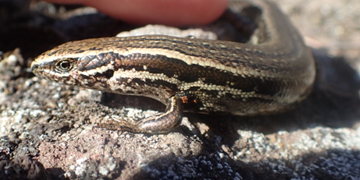Getting up close and personal with New Zealand flora and fauna is part of Citycare Property’s work in open spaces – nevertheless relocating 72 native lizards recently was an unusual request.
Flood prevention work at South New Brighton in Christchurch’s eastern suburbs involves the construction of a 700-metre bund from Beatty Street to Bridge Street plus paths, planting and setting up irrigation systems.

The new bund links to two others previously constructed by Citycare Property Landscapes team.
As part of this environmental project for Christchurch City Council, the team followed a strict Lizard Management Plan, which meant methodical removal of all the lizards from the construction area ahead of the commencement of earthworks.
Looking after our flora and fauna
“We worked with the Christchurch City Council herpetologist (a zoologist who studies reptiles and amphibians) to ensure we met specific requirements to protect the lizards,” Landscapes Project Manager Aaron Martin says.
“No one had done this type of relocation before so we were all learning together, learning some very specialist new skills,” he says.
“The area was very rugged and overgrown and the team did an excellent job, which was commented on by our client,” Aaron says.
Two trapping techniques were used on the site to catch the endangered Southern grass skinks (Oligosoma aff. polychroma Clade 5) and McCann’s skinks (Oligosoma maccanni).

Pitfall traps are a 1.1-litre pail dug into the ground with a plywood lid which entices lizards into it with tempting food. The lizards are trapped as the pail is too deep for them to get out of.
Artificial retreats are made of a piece of Onduline, a roofing product, which warms up in the sun and attracts sunbathing lizards to bask under them. The herpetologist then quickly captures the lizards by hand when the Onduline is lifted.

It took two and a half weeks to capture the lizards, which were released in other parts of Bridge Reserve where groundworks are not taking place, Aaron says.
While the team was preparing the area, mowing grass in sections, they were told many other lizards would have relocated safely outside of the mowing zones due to the noise, he says.
